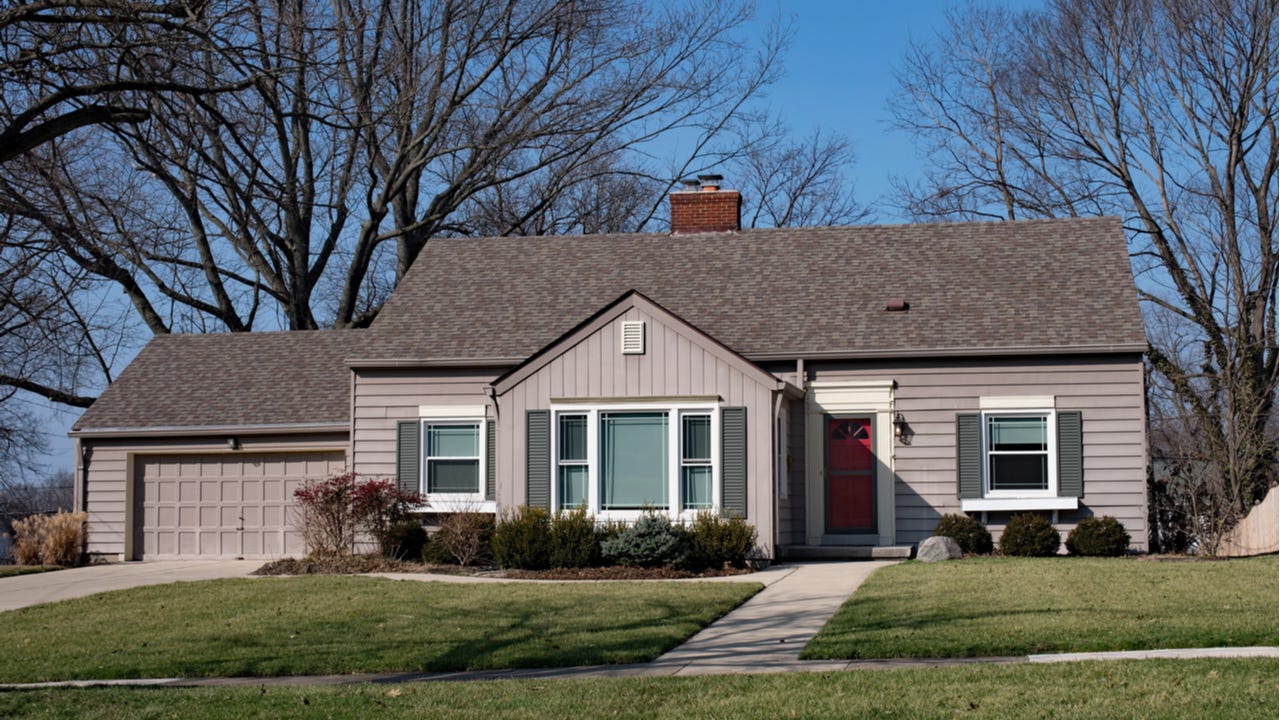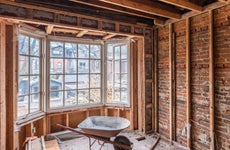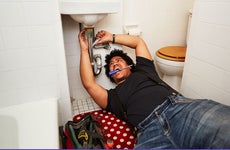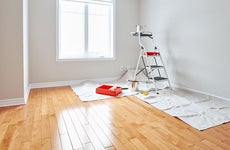Does your home need structural repairs? How to tell and what to do

The Bankrate promise
At Bankrate we strive to help you make smarter financial decisions. While we adhere to strict , this post may contain references to products from our partners. Here's an explanation for .
Whether you live in an apartment, condo or single-family house, you want to know that your dwelling is safe — not just in a safe neighborhood, but physically sound, too. Structural problems with your home can be dangerous, but they can also affect your home’s price when you come to sell. For this reason, it’s important to know what structural problems can affect your home, how to identify them, how they might affect you, and how to deal with them.
What are home structural issues?
Structural issues with your home come in many shapes and sizes, from relatively easily fixed problems like a small roof leak to major issues such as subsidence (the gradual sinking of the ground under your home). The most common signs of structural issues are:
- cracks in your walls or foundation
- bulging/bowing walls
- doors or windows no longer flush in their frames
- pooling water
A structurally sound home is one that doesn’t have any of these problems. They can indicate subsidence, instability and poor sealing or malfunctioning HVAC systems.
Being 100 percent certain about your home’s structure usually requires professional consultation, but just about anyone can spot obvious problems. In general, it’s a good idea to get a home inspected before you move in, and then keep up a regular maintenance regimen to ensure everything stays in good shape.
To really get down to the brass tacks of structural issues, though, you’ll want to hire a professional inspector or engineer.
“It’s cute to try to predict everything that’s wrong but a pro has to do it for you,” says Nick Gromicko, founder of InterNACHI, the International Association of Certified Home Inspectors. “It would be like you looking at your own X-rays before the doctor comes into the room.”
How do I know if my house is structurally sound?
There are four basic kinds of warning signs that can alert you to more serious issues and should prompt you to hire a professional right away.
1. Cracks
No matter where they show up — in your wall, ceiling, foundation or chimney — cracks or crumbling can be bad news. Cracks can be caused by structural instability or uneven settling, and could signal major, costly damage down the road.
You might see cracks in your paint as seasons change or a new house settles, and those kinds of superficial imperfections aren’t usually reason to worry — but if the crack is more than a quarter of an inch wide or grows over time, have it checked out. You should also pay attention to the direction of the crack; horizontal cracks are more likely to indicate real structural problems, because they indicate that your walls are under lateral stress.
What to do: If you notice a large crack that is growing over time, you should ask a professional to come and survey your house. It’s very difficult to measure subsidence or settling yourself, and you’ll need to get to the bottom of the problem in order to plan your next steps.
2. Bulging / Bowing / Uneven Walls and Windows
A bulging floor, bowing walls or doors or windows that no longer sit level in their frames can also point to structural issues with your home. Bulges and bows and bad fits of this type can be caused by structural instability or uneven settling, mainly. This kind of issue can be a precursor to major, costly damage to the entire house down the road.
What to do: When it comes to walls, doors and window openings are the most vulnerable parts — and are often the areas where problems first become apparent. So you should check them every few months to make sure there are no problems emerging. If you notice this kind of issue, your next move should be to consult a professional, who can assess the damage and work out the ultimate cause.
3. Water Pooling or Leaks
Another major headache for homeowners is water infiltration. It’s indicated as frequent puddles in your home or perpetually damp walls, and it can be caused by a leaky roof or pipes, or poor weather sealing. This might seem like a minor issue, but it’s not: Ongoing water damage can be costly to fix and lead to other problems like mold. A leaky roof can also become unstable as water slowly wears away the material that supports it.
What to do: You can generally tell what the source of the water is by monitoring when it occurs. If you regularly see little pools in your basement when it rains, you are likely to have a leak in your roof or walls somewhere. If you notice that you have damp walls, or a drip when someone uses the shower, it’s likely that the problem is with your plumbing. Thankfully, this is often a less complex issue to fix: Call in a plumber to identify which pipe or seal is leaking, and get it replaced.
4. Sinking
Sinking means your house is moving too deeply into its foundation. Every house is expected to settle into its foundation somewhat, causing it to sink a little over the years. But if it does so by any more than a few inches and/or does it suddenly enough for you to notice, you might have a problem. Sinking can be caused by poor foundation construction, or changes in the moisture content of the soil underneath your house.
Sinking is often indicative of foundation damage, and can be accompanied by some of the other issues on this list, so you might see cracks appearing in your walls as well, or even water leaks if the problem persists long enough.
What to do: If there are signs that your house is sinking, you should act fast. A licensed foundation repair contractor or a structural engineering firm will be able to perform a visual inspection of the structure and suggest the way forward. It might be possible to reinforce your foundation, for example, or to insert concrete piers under your house that will stop the subsidence.
Structural issues and home sales
You should look out for structural issues if you are buying or selling a house, but the best course of action often depends on which side of the deal you’re on.
Advice for buyers
Assuming you haven’t agreed to waive the inspection contingency that’s in most real estate contracts, get an inspection on your new home before you close. The inspection report should alert you to any major structural issues and can help you plan ahead for expensive repairs that may be coming your way.
“You’re thinking about your health and safety, whether you can insure it and whether you can afford it,” Gromicko says. “That’s a great way to read an inspection report.”
An inspection report that reveals extremely expensive issues, like a cracked foundation or abandoned utility that needs to be abated, could scuttle a real estate deal. Once you have the results, talk to the seller and see if you can get concessions on the purchase price to cover necessary repairs. If the work that’s required means you can no longer afford the property and the seller won’t budge on the price — or pay for fixes — you may have to walk away.
If you do decide to go through with the purchase, get an estimate from the inspector or — better yet — a contractor to make sure you have enough money set aside to cover any work that needs to be done immediately. Talk to your inspector about the results and take their advice on how much the repairs could cost.
If you’re moving into a place with a homeowners association community (HOA), you might also be able to reach out to the board for information about the property. Many HOAs require inspections prior to sale, and those reports should be available — though you may have to ask. It’s also a good idea to be in touch with the HOA about any additional charges you may incur or applications that are necessary for the kinds of repairs you expect to do. That way you can budget enough time and money to meet those requirements.
Advice for sellers
As a seller, you’re required to disclose any structural issues you’re aware of in your home prior to closing, or even to listing (in many states). If you’re selling a home you’ve inherited, you might be able to sell it with no disclosures, since you weren’t there to know about any issues. Even so, check your state’s real estate sales laws to be clear where your responsibility begins and ends.
In such cases, Gromicko recommends you always sell the home as-is to reduce your own liability.
If you’re selling your own home and have disclosed a major issue, be prepared to negotiate with buyers. Some people prefer to get a fixer-upper so they can finish things to their own taste, but others might want the home to be in turnkey condition — or at least, free of major damage that could hurt their health or impede their moving in. and expect major repairs to be done before closing.
You may have to renegotiate the purchase price, depending on how the buyer wants to proceed. If you do agree to make the repairs instead, you might want to push back closing day. If you agree to just finance them, be aware that you could be responsible for those expenses long after you hand over the title.
Next steps in making structural repairs
Once you’ve identified a problem with your home, here’s how you should proceed:
1. Get a professional to evaluate the issue as soon as possible. He or she will be able to assess how serious it is, and should be able to advise on what, if any, repairs will be required and what they might cost. You should hire a licensed foundation repair contractor or a structural engineering firm to do this inspection.
Unfortunately, it can be difficult to get a past report on your property because the results of home inspections are confidential to the person who contracted for it. That said, if you know your home’s previous owner, or if you have a copy of the inspection report you likely received when you moved in, it can be helpful for comparison.
Depending on the issues you’ve identified, an inspector might be able to get a closer look through non-destructive testing methods. Certain inspections may require walls to come down, for example, but non-destructive methods leave your home intact, meaning you won’t need to do any repairs as a result of the inspection itself.
2. Take advice on what kind of contractor you need. Once you know what the problem is, you should look for a contractor who can fix it. If your house is subsiding or settling, you might need to talk to a foundation engineering firm. If you have a water leak in your roof or wall, specialist firms exist for that. The best advice here is to talk to your inspector, and see what sort of professional they recommend.
3. Contact your insurance company. Fixing structural issues can be very expensive, but you might not have to pay the whole cost yourself. If you have homeowners insurance, your insurer might be obligated to cover some of this. Make sure you contact your insurance company before you start any work, though, because they are likely to want to agree to any major changes to your home up-front.
Bottom line on detecting structural issues
For most people, their home is their biggest investment, and keeping it in tip-top shape is part of making sure it maintains its value. Especially as you prepare to move in or move out, get the home inspected and address any structural issues that could become dangerous. Ignoring problems could mean they become more destructive over time and ultimately costlier to fix.
Related Articles


Little things, big problems: warning signs of structural damage in your home


The top 4 home renovation mistakes — and 4 tips for avoiding them